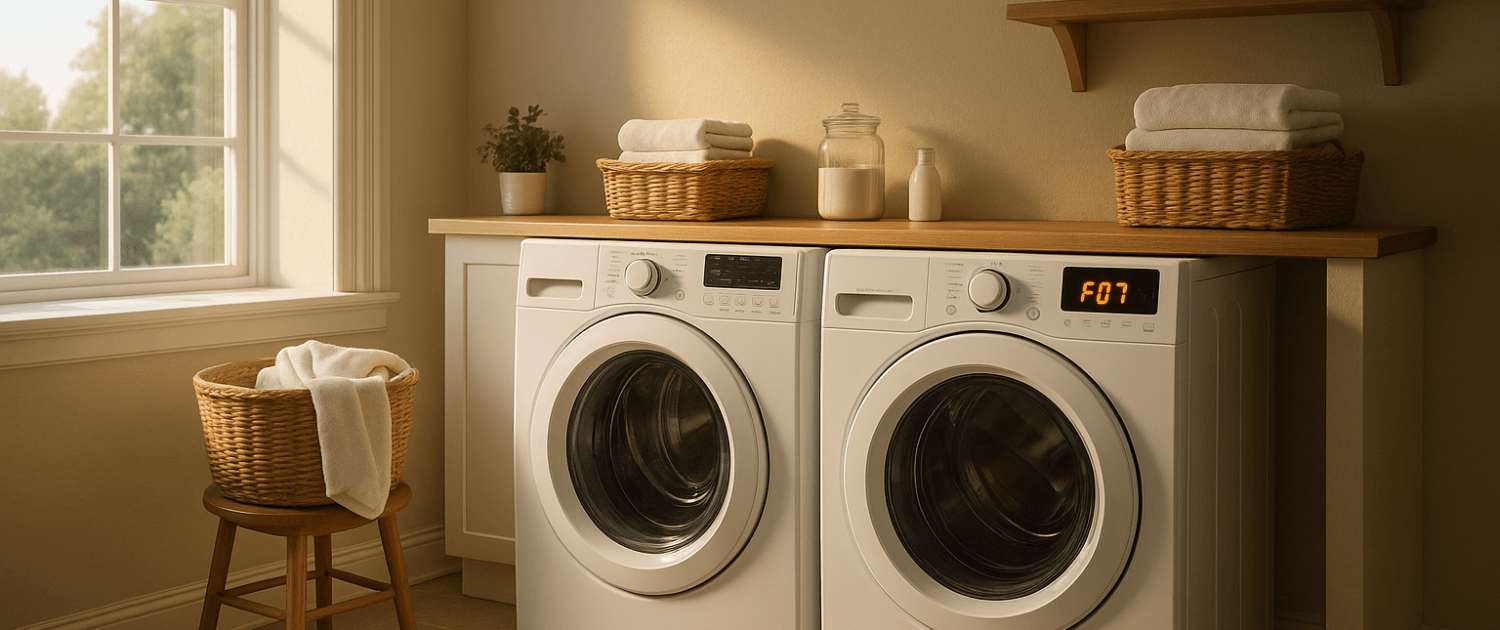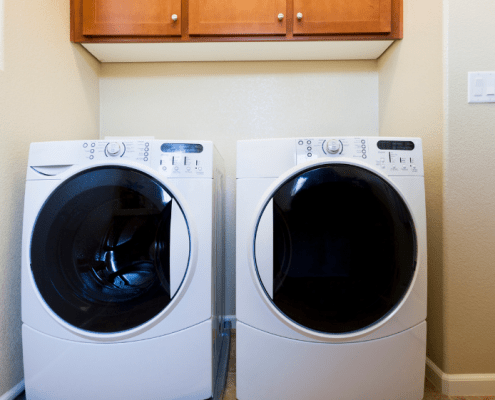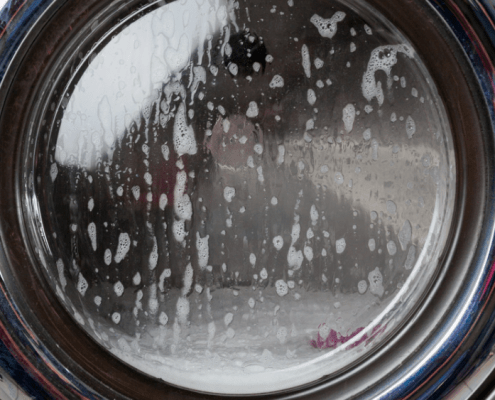How to Troubleshoot the Whirlpool Washer F07 Error Code
Steven E / Thursday May 8, 2025
Is your Whirlpool front-load washer showing an F07 error code and not operating correctly? Don’t panic – this error is generally caused by a problem with the drive motor tachometer. This comprehensive guide will walk you through how to properly troubleshoot and resolve the F07 Whirlpool washer error code.
If you find out that you need any replacement parts for your appliance while you’re troubleshooting, you can enter your model number at AppliancePartsPros.com to order them. Most orders arrive in just two business days, and we have thousands of free guides to show you how to install your new parts.
The information in this article may not apply to your specific appliance model. We recommend consulting your manufacturer’s documentation or contact us with any questions.
What does the error code mean?
On select Whirlpool washing machine models the F07 error codes indicate a fault with the drive motor tachometer circuit. The tachometer is a small electronic component connected to the rear of the drive motor, opposite the drive pulley.
This tachometer monitors the motor’s required speed and direction of rotation during a wash cycle. It sends feedback signals to the central control unit (CCU) via the motor control unit (MCU) so the washer can operate the motor properly throughout the wash cycles.
When the CCU receives inconsistent signals from the tachometer, it cannot accurately determine motor speed. This will cause the control unit to halt operation and display the F07 fault code.
If the error occurs during high-speed spin, the door will also unlock after 3 minutes as a safety precaution. Understanding what the F07 code signifies will help you pinpoint the problem.
Safety precautions
When working on any appliance, remember to keep safety first. Here are some tips to keep in mind:
- Always power off and unplug your appliance or switch off the circuit breaker before attempting any maintenance or replacement work. This keeps you safe by preventing any risk of injury from electric shock.
- Wear insulated work gloves to protect your hands from sharp metal parts, pinching hazards and debris.
- Take your time and don’t rush while working to prevent accidents and personal injuries.
- Work in a well-lit area so you can clearly see and access the interior parts.
- Clear your workspace of clutter and other obstacles. Keep children and pets away from the work area.
- Never work on internal parts with bare wet hands. Make sure the work area is completely dry.
- Check your user manual to see if there are specific installation or safety instructions for your part or appliance.
- Be gentle when handling or removing parts. Excessive force might damage the appliance or cause injury.
- Wear safety glasses when working with chemicals, dust or cleaning large debris to prevent injury.
- If the appliance has recently been used, give it plenty of time for any heating parts to cool down before working on it.
- Take pictures or make a note of wiring terminals or other connections before disconnecting to prevent any problems with reassembly.
- When working with wires, avoid touching any exposed wires or terminals. If you need to touch a wire, use a non-conductive tool or wear insulating gloves to prevent electrical shock.
Troubleshooting steps
Follow these steps carefully to diagnose and resolve a motor tachometer failure causing the F07 error:
Verify power to the washer
First things first – make sure the washer is plugged in fully and receiving power. Check for any tripped breakers or faulty outlets that could disrupt the power supply.
Inspect all electrical connections
Unplug the washer and access the back to visually inspect all wire harness connections. Check that the connections between the drive motor, tachometer, MCU, and CCU are secure with no corrosion or damage. Faulty connections due to a short circuit or loose wiring can cause the F07 error.
Inspect the tachometer and motor
Carefully inspect the physical condition of both the tachometer and the drive motor. The tachometer is attached to the rear of the motor, opposite from the drive pulley.
- Check that the tachometer is firmly affixed in place and the wiring is intact. Look for any cracks, damage, or detached/corroded connectors.
- On the motor, look for signs of overheating like discolored/melted plastic or corroded windings. Check for bent or seized shaft, damaged or binding bearings, worn drive pulley, etc.
- Rotate the motor shaft by hand to feel for smooth operation. Grinding, looseness, or knocking noises signal a bad motor needing replacement.
Thoroughly inspecting these components can reveal physical damage that explains the tachometer malfunction.
Test the motor windings
Use a multimeter to check the motor windings resistance:
- Disconnect wiring from motor terminals
- Set multimeter to low ohms range
- Check resistance between pairs of windings. Should measure around 6 ohms.
- If readings are very high or infinite, the windings are open.
- Very low or zero readings indicate shorted windings.
- All three winding readings should be balanced. Large mismatches signify a bad motor.
The windings must be intact for the tachometer and motor to work correctly.
Verify motor pulley and belt
Manually spin the motor pulley and drive belt to confirm they rotate freely without any grinding, catching, or seizure. A locked pulley can prevent proper operation.
Issues with the drive pulley and belt can negatively impact the tachometer:
- Remove the belt and manually rotate the pulley to check for binding, grinding, and wobble.
- Inspect the belt for cracks, fraying, and excessive wear.
- Check the pulley and shaft for damage, set screws tight, key is in place.
- Ensure belt tension is correct – too loose can allow belt slippage.
- Replace defective pulley, belt, or motor shaft if any issues are found.
Proper drive train operation is crucial for the tachometer to read motor speed accurately.
Replace motor control unit
If the above checks are okay, the issue likely lies with the MCU. This component interprets tachometer signals to control motor operation. Replace the faulty MCU.
To replace the MCU:
- Unplug the washer and disconnect all wiring from MCU.
- Remove mounting screws to extract MCU from the washer.
- Install replacement MCU and refasten mounting screws.
- Reconnect wiring according to the wiring diagram, ensuring connections are secure.
- Power on the washer and test for proper operation.
The MCU converts tachometer signals to control motor speed/direction. Faulty MCUs are a common cause of F07 errors.
Replace central control unit
If replacing the MCU does not correct the problem, the CCU will need to be renewed. The CCU is more commonly known as the control board and acts as the brain of the unit. It communicates with the MCU to operate the motor.
If the CCU is determined to be faulty:
- Unplug the washer and disconnect all wiring and mounting clips from CCU.
- Remove the old CCU from the washer cabinet and install the replacement part.
- Firmly reattach all wiring connectors and mounting hardware.
- Power on the washer and run a test cycle to confirm F07 error is resolved.
The CCU communicates with MCU to operate the motor. If the tachometer circuit still fails after replacing MCU, the CCU is likely bad. You can purchase a new OEM replacement one for your select model by clicking here.
Reconnect all components, plug in the washer, and rerun a test cycle. The F07 error should not reappear if the problem was properly diagnosed and repaired.
Additional information
Thank you for reading! We hope this guide helped you get your washer working again.
If you have any other appliance repair needs or projects, don’t hesitate to explore our other troubleshooting guides and videos.
If you need replacement parts or some extra help with ordering them, grab your model number and head over to AppliancePartsPros.com, where you can chat with a pro, read our DIY blog and more.
Don’t forget to subscribe to us on YouTube and follow us on Facebook, Twitter and Instagram!
With nearly a decade of experience in providing top-notch customer service regarding appliance parts and repair, Steven enjoys sharing practical advice, troubleshooting tips, and interesting information to help readers stay informed.





